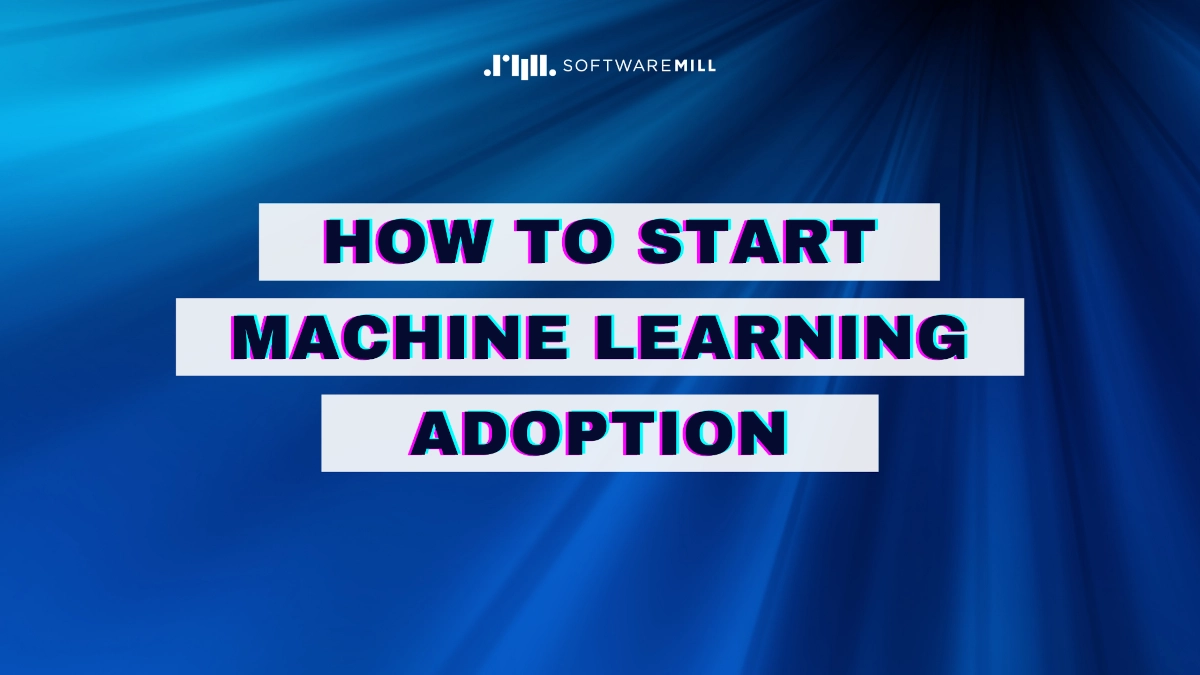How to start machine learning adoption

Adopting ML in your company
Machine learning is on the rise and has gained even more traction over the last couple of years. Many organizations see the potential for ML in their processes and as ML adoption accelerates, they have to face new challenges — and some leaders say it's going too fast.
Concerns that AI is overhyped and widespread are rising. 74% of executives say the use of AI to help businesses is more hype than reality right now.
source: Thriving in an AI world, KPMG
It's no wonder business executives are optimistic about the promises of AI/ML solutions but it's also hard to overlook the obvious risks. According to Pactera Technologies, even 85% of AI projects fail to deliver on the promises of bringing tangible business value.
Wait, so is there even a point in adopting machine learning?
There is, but it's crucial to remember that ML is an addition to your business and a means to achieve objectives and it should only be adopted when there is a clear use case and it can bring actual value.
Machine learning adoption: first steps
The beginning of your first ML project is focused on the right preparation: connecting your business needs and the currently available ML technologies to build a viable use case, understanding the state of your data, acquiring the skill set required to bring the project to life.
In McKinsey's "An Executive's Guide to Machine Learning", you can find:
"C-level executives will best exploit machine learning if they see it as a tool to craft and implement a strategic vision. But that means putting strategy first. Without strategy as a starting point, machine learning risks becoming a tool buried inside a company’s routine operations (...)"
source: An Executive's Guide to Machine Learning
The above is true and that is why the first steps towards implementing machine learning in your organization should be strategic. Let's outline the most important things you should have worked out before you open your first ML project.
What problem do you want to solve with machine learning?
That's the imperative question, a compass that shows you the way towards a given ML solution, or another technology as machine learning doesn't have to be the best possible solution to the problem your business is facing. Only when you know what you're fixing with the help of ML can you match it with technology.
How can ML solve your problem?
Or can ML solve it in the first place?
Before you get to the "how", you need to know what can be achieved. ML engineers/consultants should be able to tell you whether ML is a viable idea or guide you towards a better-suited solution if there is such.
It's important to remember that ML activities are of a research nature and can fail to deliver, so it's crucial to validate the idea before going into full-blown ML projects.
At this point, you've already learned that it's worth giving ML a try, you're working your way through ideation workshops and describing your use case. ML engineers, who are an essential part of your team from now on, will help you map out the details of your ML solution, plan for its prototyping and further development, and provide you with all the insights you'll need along the way. Don't forget that the project should be assessed: you'll need success and failure criteria and relevant metrics to check the results.
Do you have the relevant data?
Chances are you know what data you have and what data can be used in solving your problem but since data is at the heart of every ML project, give it a careful look. You know what they say, garbage in = garbage out. If you don't pay sufficient attention to the data you're feeding to your ML model, you can't expect anything good to come out of it. But let's look at the bright side of life: taking relevant data, you can often uncover new information and spot things that previously went unnoticed.
Your ML team (an interdisciplinary one, built of ML engineers and domain experts from your company or other experts if necessary) will list the data that's needed — what you have, what you're missing, what has to be done. Since we're only focusing on the strategic first steps preceding the kickoff of your ML project, I won't be going into detail about data engineering, however, I recommend you check the "Exploring a dataset" series by Mikołaj Koziarkiewicz, our ML engineer.
Do you have the required skillset?
To deliver the ML project and to work with the result. You need machine learning engineers to work on the project but you might also need to train some of your staff to work with the new solution.
If you're wondering how to assemble your ML team and avoid the common challenges of the process, check out this article on our blog.
Starting a machine learning project
Going into the first ML project requires you to have a close look at your objectives, needs, and overall strategy to help build the use case and validate the idea. As you can see, machine learning starts with an idea and the strategy around it to best plan and execute the project. The key is to quickly validate whether ML can help you achieve your goals so you know it's a worthwhile investment.
Need help making your first steps in ML? Reach out to our team and tell us about your needs!

